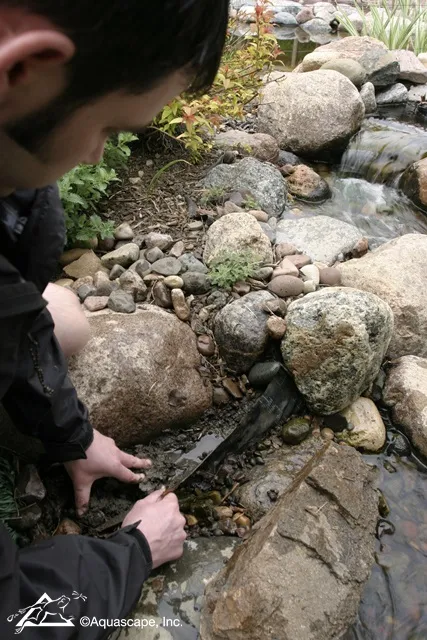My heart sank as I gazed upon my once-pristine pond, now a shallow puddle marring my backyard’s tranquility. A leak had sprung, threatening to drain its lifeblood and rob us of its serene allure. Determined to restore this watery oasis, I embarked on a quest for knowledge, seeking the secrets to mending its breach.

Image: www.aquascapeinc.com
**Pinpointing the Elusive Leak**
The most common culprits of pond leaks lurk within the liner or plumbing system. Inspect your liner thoroughly for any tears, holes, or wrinkles. Check the edges where it meets the pond walls, as this is a prime location for leaks to develop. As for the plumbing, examine all pipes, pumps, and hoses for any cracks, loose connections, or leaks. If the leak remains elusive, consider consulting a professional pond installer for assistance.
**Sealing the Breach: A Step-by-Step Guide**
Once you’ve identified the source of the leak, it’s time to don your waterproof gloves and get to work. For minor tears in the liner, a patch made of self-adhesive pond liner material will suffice. Clean the spot, apply the adhesive, and press the patch firmly into place. Smooth out any air bubbles for a secure seal.
Larger tears may require a more substantial fix. Cut a piece of liner slightly larger than the hole and create a sandwich with the existing liner. Apply adhesive to both surfaces and place the patch over the tear, sandwiching the liner in between. Weight the patch down with rocks or bricks to ensure proper bonding.
Pipe leaks can be tricky to handle. First, try tightening the connections using a wrench. If the leak persists, you may need to replace the pipe or coupling. Ensure that the new pipes are properly fitted and sealed with tape or paste. Cracks in pipes can be sealed with epoxy putty, but it’s best to replace the damaged pipe as soon as possible to prevent future problems.
**Beyond the Quick Fix: Preventative Measures**
Once your pond leak is sealed, it’s crucial to take preventative measures to avoid a recurrence. Inspect your pond regularly for any signs of wear or tear. Clean the liner, nets, and pumps periodically to remove debris and potential causes of leaks. Trim any vegetation that could grow through the liner.
For added protection, consider using a pond leak sealant to create a protective barrier on the liner’s surface. This can help prevent future tears and leaks, prolonging the life of your pond. Consulting a professional pond installer can provide valuable advice on preventative measures tailored to your specific pond.

Image: www.thepondguy.com
**FAQ on Leaky Ponds**
Q: Can I fix a pond leak myself?
A: Yes, many minor pond leaks can be repaired by do-it-yourselfers with the right materials and know-how. However, complex leaks or plumbing issues may require professional assistance.
Q: How long will a pond leak sealant last?
A: The lifespan of pond leak sealant varies depending on the quality of the product, the frequency of exposure to chemicals and UV rays, and the overall condition of your pond. Most sealants last for several years, but it’s recommended to inspect your pond regularly and reapply the sealant as needed.
Q: Can I use duct tape to fix a pond leak?
A: While duct tape may provide a temporary fix, it’s not a recommended solution for long-term pond repairs. Duct tape can break down over time and release adhesives that could harm your pond’s ecosystem and inhabitants.
How To Fix Leak In Pond
**Conclusion**
Restoring a leaky pond to its former glory is an achievable feat with the right knowledge and preparation. By following the steps outlined above, you can seal the breach, prevent future leaks, and ensure that your backyard oasis continues to bring joy and serenity for years to come.
Share your pond leaks and repairs in the comments below. Your experiences and insights can help others navigate the challenges of leaky ponds.